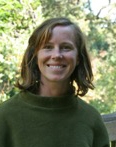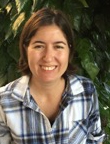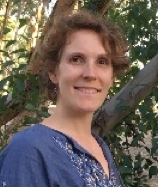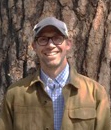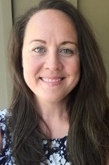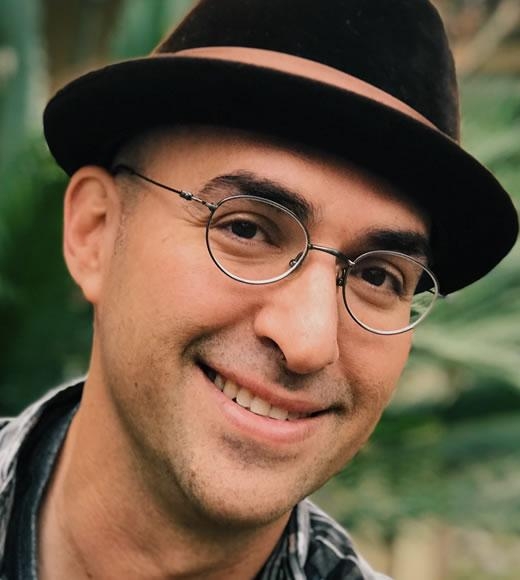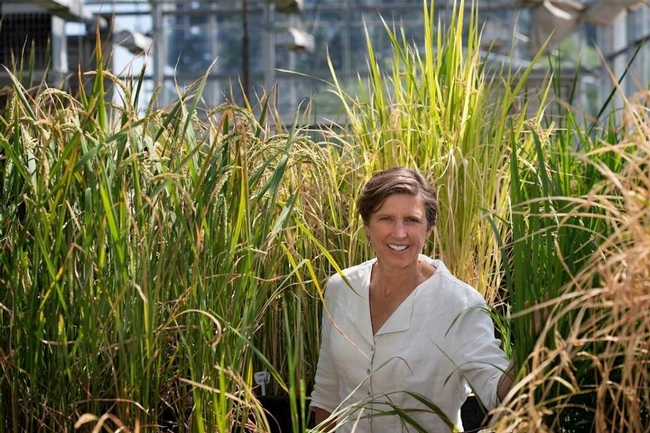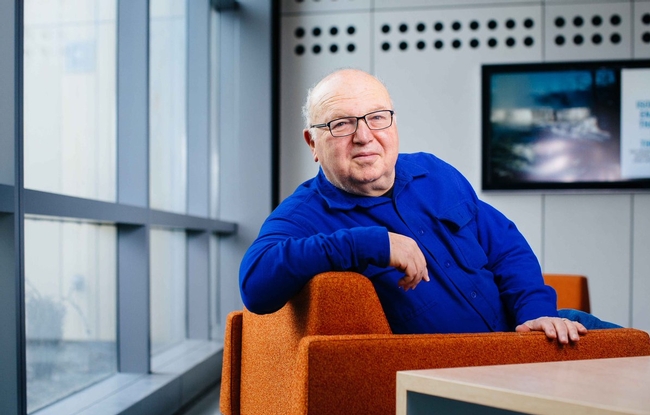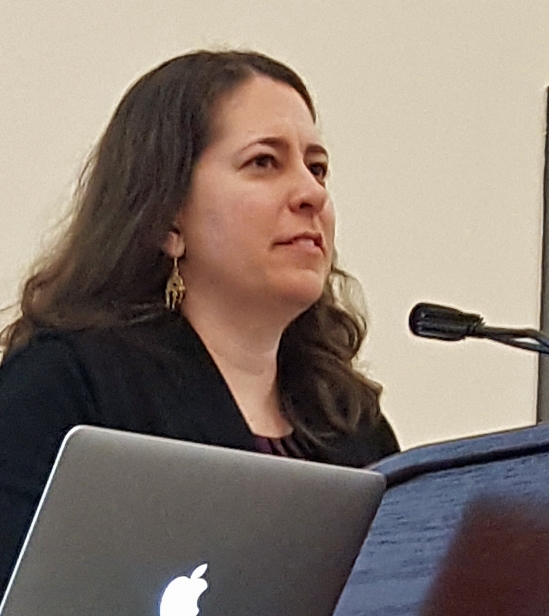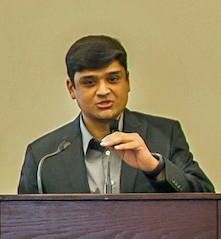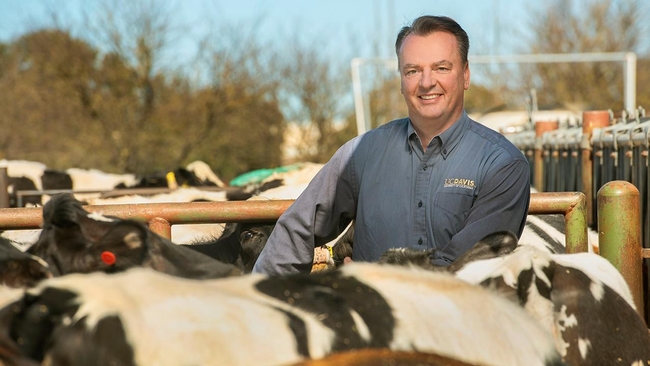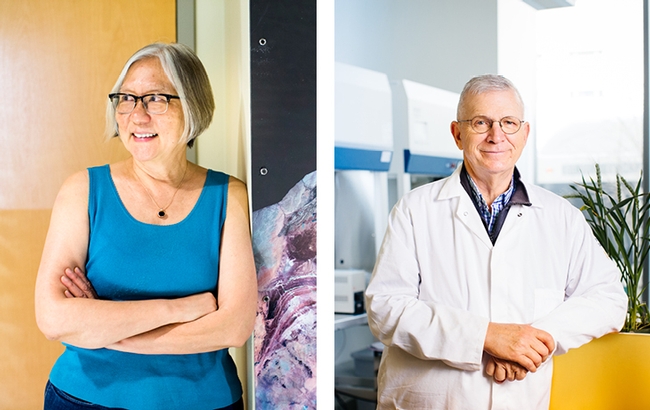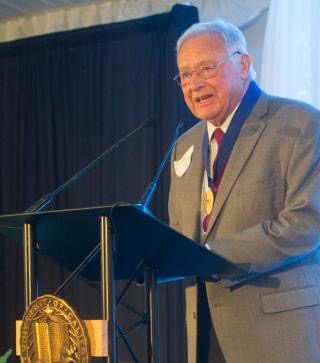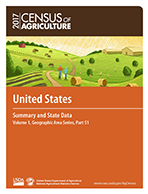Posts Tagged: March-April 2019
Names in the News
Coyne named Master Gardener volunteer engagement coordinator
Marisa Coyne is now the academic coordinator - volunteer engagement for UC Master Gardener Program as of April 8. Coyne joined the Program after serving as a part-time community education specialist for the 4-H Youth Development Program with UCCE Marin County since September 2018.
“Marisa is filling a new full-time position and we are delighted to have her as part of the UC Master Gardener community,” said Missy Gable, director of the UC Master Gardener Program.
Coyne will strengthen and further the work of the Program by enhancing professional development opportunities, collaborating with UC ANR academics to ensure successful volunteer-academic partnerships, and sharing stories of UC Master Gardener volunteers' many accomplishments and successes. She is passionate about creating opportunities for community members to commit to lifelong stewardship of land and water in California.
Originally from Philadelphia, she has worked in rural, urban and peri-urban communities and in food, agriculture and wilderness spaces, providing interdisciplinary, inquiry-based, educational opportunities for learners of all ages. From the California coast to the Driftless Area of Wisconsin to the forests of Connecticut, she has designed and delivered outdoor experiences for thousands of learners, specialized in development of emerging leaders and in promoting inclusive organizational change. Her graduate work at UC Davis in the Community and Regional Development Program focused on issues of equity in sustainable agriculture education. She earned a M.S. in community development from UC Davis and a B.A. in communications from Temple University.
Coyne is located in the ANR building in Davis in workstation 102B and can be reached at macoyne@ucanr.edu or (530) 750-1394.
Hollingsworth named UCCE nutrient management and soil quality advisor
Joy Hollingsworth joined UC Cooperative Extension as a nutrient management and soil quality advisor serving Fresno, Kings, Madera and Tulare counties on April 1. She had worked as a staff research associate at the Kearney Agricultural Research and Extension Center (KARE) since 2015.
As a staff research associate at KARE, Hollingsworth assisted in the management of drought and variety studies in the field, greenhouse and lab on both forage and grain sorghum. She organized trials, collected growth and development data, coordinated field activities with research station staff, supervised work crews at KARE and WSREC, and operated harvest equipment such as forage chopper and small plot combine. Prior to her work as an SRA at KARE, Hollingsworth was a junior specialist in the UC Davis Plant Science Department, conducting agronomic field trials for canola, camelina, sugarbeets and castor, including variety, salinity, irrigation and nitrogen trials located throughout California.
Hollingsworth earned a M.S. in plant science from Fresno State. Her thesis project was conducted at the UC West Side Research and Extension Center and compared overhead irrigation to subsurface drip in conservation tillage cotton. She earned a B.A. in communication from UC Davis.
Hollingsworth is based in Fresno and can be reached at (559) 241-7527 and joyhollingsworth@ucanr.edu.
Nobua-Behrmann named UCCE urban forestry and natural resources advisor
Beatriz Nobua-Behrmann is now a UC Cooperative Extension urban forestry and natural resources advisor serving Orange and Los Angeles counties, effective March 25. Nobua-Behrmann first joined ANR in 2017 as a staff research associate in Orange County.
As a staff research associate for UCCE Orange County, Nobua-Behrmann provided management and direction to conduct a significant research and extension program focused on critical invasive pests, mainly insects, impacting urban landscapes and wildlands surrounding urbanized environments. The main focus of the program is to conduct surveys of infestations in regional parks and associated open spaces in order to develop management strategies that are efficacious and economically feasible. She also coordinated research and extension activities conducted by UC Riverside faculty and UCCE specialists on pest-related issues impacting these same environments.
She completed a doctorate and a B.S in biology from Universidad de Buenos Aires in Argentina and is fluent in Spanish.
Nobua-Behrmann is based at South Coast Research and Extension Center in Irvine and can be reached at (949) 301-9182, Ext. 1006 and benobua@ucanr.edu.
Tompkins named forestry and natural resources advisor
Ryan Tompkins joined UC Cooperative Extension as a forestry and natural resources advisor on March 18, serving Plumas, Sierra and Lassen counties. Prior to joining UCCE, Tompkins held forester positions for the past 16 years with the U.S. Forest Service, worked in the fire effects program with the National Park Service and served as associate faculty in the Environmental Studies Department at Feather River College teaching forest ecology and management.
Most recently, Tompkins served as the forest silviculturist and vegetation program manager at the Plumas National Forest, where he designed, planned and implemented landscape-scale forest restoration projects.
Tompkins earned master's and bachelor's degrees in forestry from UC Berkeley.
Based in Quincy, Tompkins can be reached at (530) 83-6125, retompkins@ucanr.edu.
Nelson joins ANR as climate stewards initiative academic coordinator
Sarah-Mae Nelson joined ANR as the UC climate stewards initiative academic coordinator on Feb. 19. She is an educator, science communicator and climate change communication specialist who draws on her background and interest in interpretation at informal science education centers.
Prior to joining ANR, she worked for the Monterey Bay Aquarium from 2006 to 2017 in various roles, including guest experience interpreter, climate change interpretive specialist, and conservation interpreter and online community manager for ClimateInterpreter.org. A charter member of the National Network for Ocean and Climate Change and Interpretation, Nelson is part of the leadership team that trains new communicators in research-proven, climate change strategic framing communications. For her master's work, she established curriculum for an interdisciplinary Climate Change Studies minor at UC San Diego. In 2015, she was recognized by President Obama as a Champion of Change in Climate Education and Literacy.
She earned an M.S. in climate science and policy from Scripps Institution of Oceanography, UC San Diego, and a B.S. in marine biology from UC Santa Cruz.
Nelson is based in Half Moon Bay and can be reached at (408) 482-4633 and smanelson@ucanr.edu.
Gross named UCCE aquaculture specialist
Jackson Gross joined UCCE on Aug. 14, as an aquaculture specialist. His current research program aims to be at the forefront of environmental and production sustainability and ecological integrity. To achieve this vision, his research is focused into three distinct, yet overlapping applied research themes: aquaculture, invasion biology and environmental/ecological toxicology. This research usually addresses data gaps and provides scientific solutions, determined through rigorous experimentation, meeting the immediate biological and engineering needs of the aquaculture industry and natural resource community. His research is historically a mix of laboratory and field experimentation. However, there are many times where the research is not exclusively one or the other, but instead, a blend where controlled laboratory experimentation is brought into the field. Other areas of interest include aquaponic production systems.
Prior to joining UCCE, Gross worked at a private engineering firm evaluating the effects of anthropogenic activity on aquatic resources.
Gross earned a Ph.D. in animal sciences (endocrine and reproductive physiology minor) at University of Wisconsin - Madison. He completed a M.S. in public health (toxicology emphasis) and a B.S. in biology (zoology emphasis) from San Diego State University.
Gross is based in the Department of Animal Science at UC Davis and can be reached at 2117 Meyer Hall, (530) 752-2978 and jagross@ucdavis.edu.
NAS elects Ronald and Zilberman as members
The National Academy of Sciences announced April 30 the election of 100 new members and 25 foreign associates in recognition of their distinguished and continuing achievements in original research. Forty percent of the newly elected members are women—the most ever elected in any one year to date.
Pamela Ronald, professor and geneticist in the UC Davis Department of Plant Pathology and Genome Center, and David Zilberman, a UC Cooperative Extension specialist and professor of agricultural and resources economics at UC Berkeley, are among the new members.
Ronald researches genes that control disease resistance and tolerance to environmental stress in rice, one of the world's most important crops. She is known for engineering flood-tolerant rice, for which she and her colleagues received the USDA 2008 National Research Discovery Award.
Zilberman is one of the most cited scholars in agricultural, environmental and resource economics. During the 1980s, his work served as the basis for several projects on the adoption of modern irrigation technology and computers in California agriculture. These studies demonstrated that farmers adopt new technologies when it makes economic sense and that extreme events, such as droughts or high prices, can trigger changes in farming practices. During the early 1990s, his research on pesticide economics and policy made the case against policies that called to ban pesticides, and advocated instead for policies that take advantage of the vast economic benefits that pesticides generate while using incentives to protect against environmental side effects. In January, Zilberman was awarded the 2019 Wolf Prize in Agriculture in recognition of his work developing economic models for fundamental problems in agriculture, economics and policy.
Dahlquist-Willard and Pathak honored by CalCAN
Two UC Cooperative Extension scientists were recognized for their contributions to the field of agriculture and climate change at the California Climate & Agriculture Summit at UC Davis on March 5, 2019.
CalCAN presented the leadership award for agricultural professional to Ruth Dahlquist-Willard, UC Cooperative Extension small farms advisor in Fresno and Tulare counties.
Dahlquist-Willard helps keep small-scale, diversified farmers in business by providing support with marketing, regulatory compliance, processing of value-added products, water and energy efficiency, and integrated pest management. She has been a driving force behind increasing access by Hmong farmers in the Fresno area to California's State Water Efficiency and Enhancement Program (SWEEP). Dahlquist-Willard has promoted the program, provided thousands of hours of one-on-one, culturally relevant support to farmers on grant applications, and assisted with project design and installation. The farmers she has supported are now benefiting from water, energy and financial savings.
"There are large environmental problems to solve in the Central Valley, and it's time for a different conversation around farming there," Dahlquist-Willard said. "I feel that there needs to be a conversation in the middle to solve problems rather than a conflict-based approach."
The leadership award for researcher was presented to Tapan Pathak, UC Cooperative Extension specialist for climate adaptation in agriculture, based at UC Merced.
Pathak is the chair of the UC Cooperative Extension Climate Change Adaptation Workgroup, which brings together scientists across the UC system to collaborate on research and extension projects related to climate change adaptation in California agriculture. Pathak is the lead author on an important and timely paper that was published in 2018 in the journal Agronomy. It synthesizes the impacts of climate change on California agriculture and offers directions for future research and implementation.
"We need more facilitated dialog with policy researchers and scientists on the science of climate change, and the implications of not taking action," Pathak said. "Given the scale of California agriculture and the pressure of climate change impacts, we need even more substantial funding for incentives for farmers and for research and tools, and we must integrate growers from the beginning of the process."
The summit, organized by CalCAN, brought together some of the state's foremost experts in agriculture — including farmers, agriculture professionals, researchers, advocates and policymakers — to grapple with the challenges of climate change and share knowledge about the opportunities facing the industry.
Mitloehner wins Borlaug CAST Communication Award
The Council for Agricultural Science and Technology (CAST) named UC Davis animal scientist Frank Mitloehner the 2019 Borlaug CAST Communication Award recipient. Mitloehner, a professor and UC Cooperative Extension air quality specialist in the Department of Animal Science, is the 10th recipient of this award.
“I'm honored to be selected by CAST, an organization I've long admired, and to be in the company of so many recipients who have inspired me during my career,” Mitloehner said. “Being recognized with the Borlaug CAST Communication Award is not only a high honor, it's an affirmation of the importance of sharing research and academic pursuits well beyond labs, classrooms and universities.”
CAST bestows the award annually to a nominated expert in the agricultural, environmental or food sectors. The nominee must show remarkable communication skills through various types of media with the purpose of advancing science in the public policy sector.
Mitloehner's nominators state he reaches beyond academia to inform experts and various members of the public around the globe about animal agriculture's influence on greenhouse gas emissions. His goal is to change societal views about the influence of animals on our climate through various channels of communication.
“His involvement as a communicator and scientist at the national and global levels has put him and his message in a strategic position to share and influence policy,” said one of Mitloehner's nominators.
Numerous like-minded agencies and institutions have reached out for his guidance on timely and relevant issues regarding animal agriculture's impacts on air quality, including chairing a committee for the Food and Agriculture Organization of the United Nations.
Since he joined UC Davis in 2002, Mitloehner has amassed more than 800 presentations focused on animal agriculture through various speaking events such as conferences and professional meetings. He has contributed to national news stories published by CNN, PBS, Newsweek, The Washington Post and other media outlets.
Mitloehner does not shy away from social media either. He began tweeting with the handle @GHGGuru in April 2018 and his Twitter account has more than 7,000 followers. In late 2018, Mitloehner launched GHG Guru Blog, a personal website with the goal of delivering the “latest, most accurate research” focused on the intersection between animal agriculture and the climate.
“Science for science's sake has no role in making our world more sustainable,” Mitloehner said. “Sharing what we know — and backing it up with facts — leads to discussions and solutions,” Mitloehner said.
The Borlaug CAST Communication Award is sponsored by the CropLife Foundation. CAST announced the 2019 BCCA recipient at the USDA Whitten Patio in Washington, D.C., on April 16.
The award will be presented held during a side event at the World Food Prize Symposium on Oct. 16. – UC Davis
Fung and Staskawicz elected Royal Society members
The Royal Society of London, the oldest scientific academy in continuous existence, announced their newest fellows and foreign members April 16, among them two UC Berkeley College of Natural Resources faculty.
The newly-elected CNR foreign members are climate scientist Inez Fung and plant biologist Brian Staskawicz. Fung and Staskawicz are among 51 new fellows, 10 new foreign members and one new honorary member.
“Over the course of the Royal Society's vast history, it is our fellowship that has remained a constant thread and the substance from which our purpose has been realized: to use science for the benefit of humanity,” said society president Venki Ramakrishnan. “This year's newly elected Fellows and Foreign Members of the Royal Society embody this, being drawn from diverse fields of enquiry – epidemiology, geometry, climatology — at once disparate, but also aligned in their pursuit and contributions of knowledge about the world in which we live. It is with great honor that I welcome them as Fellows of the Royal Society.”
The learned society dates from 1660 and today is the U.K.'s national science academy and a fellowship of some 1,600 of the world's most eminent scientists.
Fung, a professor of earth and planetary science and of environmental science, policy and management, models the processes that maintain and alter the composition of the atmosphere and, hence, the climate.
Staskawicz, a professor of plant and microbial biology and a co-director of the Innovative Genomics Institute, studies plants' innate immunity with the goal of engineering disease resistance in agricultural crops.
UCPath paychecks to start Oct. 1
The systemwide UCPath Steering Committee has decided the new launch date for UCPath at UC ANR, UC Davis and UC Davis Health will be Oct. 1, with cutover activities happening in September.
The decision for UC ANR to launch UCPath on Oct. 1 comes on the heels of a smooth transition to UCPath at UC Berkeley over the last month. UC ANR's project team continues to work closely with their counterparts at UC Berkeley and other UC locations to collect lessons learned and best practices to prepare for our transition.
“I would like to express my gratitude to our UC ANR colleagues across the state who continue to maintain UC ANR's readiness to cut over to UCPath,” said Tu M. Tran, associate vice president, business operations.
The UC ANR team is using the extra time to review our readiness and focus on training and transition activities. We will continue to share information as we approach the new target go-live date.
In memoriam: Charley Hess
Charles E. “Charley” Hess, a UC Davis Medal recipient and dean emeritus of the College of Agricultural and Environmental Sciences who never took the word “retirement” seriously, died April 13 of congestive heart failure at the age of 87.
Helene Dillard, who studied for her advanced degrees in the College of Agricultural and Environmental Sciences, or CA&ES, during Hess' time as dean, is now the dean herself — fully cognizant of Hess' role in the college's status as a global leader in agriculture.
“We would not be where we are today without Charley's vision and leadership,” said Dillard, a plant pathologist who was appointed dean in January 2014 a few months before Hess received the UC Davis Medal, the campus's highest honor. “Charley was a wonderful colleague, an inspirational teacher, a tremendous mentor and a dear friend to our college and the people we serve.”
Hess earned a Bachelor of Science degree in plant science at Rutgers University, a Master of Science degree in horticulture and plant pathology at Cornell, and a Ph.D. in horticulture, plant physiology and plant pathology, also at Cornell. He joined the Purdue faculty in 1958, then returned to Rutgers in 1966 as chair of the Department of Horticulture and Forestry. He advanced to acting dean of Rutgers' College of Agricultural and Environmental Sciences in 1971 and two years later became the founding dean of Rutgers' Cook College (today known as the School of Environmental and Biological Sciences).
He became the dean at UC Davis in 1975 and held the post until 1989. His faculty appointment was in the Department of Environmental Horticulture (now part of the Department of Plant Sciences).
Born into agriculture
He was a natural in the plant world, born Dec. 20, 1931, in New Jersey, into a family with a nursery business in Wayne. He could have joined the business after college, but the science bug bit him. Still, as an academic and administrator, he developed strong relationships in agriculture at all levels, from small businesses like his family's, to industry giants — and, of course, with student farmers, too, having been an enthusiastic supporter of the UC Davis Student Farm since its inception in 1977 in his second year as CA&ES dean.
The farm eventually became part of the Sustainable Agriculture Research Education Program that was established later during his tenure as dean. He also participated in the development and funding of California's Integrated Pest Management Program and the UC Davis Biotechnology Program, and he facilitated the move of the U.S. Department of Agriculture's Western Human Nutrition Center from San Francisco to UC Davis.
He stepped down as dean, after 14 years, to accept an appointment by President George H.W. Bush to be the assistant secretary for science and education in the USDA, serving from 1989 to 1991. Prior to that, Hess had two presidential appointments to the National Science Board, the governing board of the National Science Foundation.
Hess accepts the UC Davis Medal
He was one of the principle architects of the National Research Initiative, which evolved into the competitive grants program of the USDA's National Institute of Food and Agriculture.
Yolo County farmer Richard Rominger '49, former deputy secretary at the USDA and director of the state Department of Food and Agriculture, said: "Charley was a much loved and respected leader at the U.S. Department of Agriculture and at UC Davis, recognized for his accomplishments and contributions to the greater world of agriculture, education and science.”
Back on campus, he took an appointment as UC Davis' first director of international programs in 1992. He officially “retired” in 1994 but kept right on working in international programs until 1998. He would go on to serve as special assistant to the provost and chancellor, 2003-04; and subsequently held temporary positions as chair of the Department of Nutrition and vice chancellor of research.
He was a fellow of the American Association for the Advancement of Science and the American Society for Horticultural Science, and had been inducted into the society's Horticulture Hall of Fame. The College of Agricultural and Environmental Sciences and the USDA also had honored him for distinguished service.
Hess is survived by his wife of 38 years, Eva, and their son, Peter Hess, and four children from his earlier marriage to Marie C. Lilliedoll: Mary Foster (and husband Mike Foster), Carol Hess Allan, Nancy Hess (and husband Garry Buchko) and John Hess. Other survivors include daughter-in-law Akiko Ogura; and five grandchildren, Julie (Foster) Mecca, Brian Foster, Alex Buchko, Jules Buchko and Emma Hess.
His family is planning a memorial celebration for late May. Dateline UC Davis will post an announcement when the arrangements are final.
Other contributors to this report: Diane Nelson, senior writer in the College of Agricultural and Environmental Sciences; Maril Stratton, associate chancellor emerita; and Pat Bailey, retired senior public information representative.
Read the full story at https://www.ucdavis.edu/news/dean-emeritus-charley-hess-dies-87.
Workgroups, program teams and strategic initiatives review shows clarity of purpose
A major factor in job satisfaction is the extent to which people feel part of a wider supportive community. Such connections have historically been offered in UC ANR through various means, including our structural units (i.e., our 81 workgroups, 21 program teams and 5 strategic initiatives).
Healthy organizations should regularly look at their structure. Important elements of structure include how the pieces fit together and how people may better connect to more effectively implement their work. In the summer of 2018, we began a series of discussions and surveys to revisit aspects of our structure.
Thank you to the 120-plus people who provided input on our structure and suggestions regarding how we may connect.
Findings
1. Clarity of purpose:
The seeming fuzziness of the roles and goals of our workgroups (WGs), program teams (PTs) and strategic initiatives (SIs) is not as great as people may think. Many consistent findings arose across the different structural groups. A summary of our findings follows.
Workgroups (our oldest unit of structure) are the most readily understood. They represent active “communities of practice” (that can come and go) and are the primary place where people plan and implement (noting that such groups are both formal and informal).
One point of interest is that people didn't realize they could close or start workgroups as needed.
Program teams bring together people (typically from different workgroups) who are working on related but distinctly different topics to network, share and learn.
One clear observation is that PTs vary considerably in terms of the diversity of WG representation (e.g., 1 PT has 12 WGs and a few PTs have just 1 WG).
SIs are our highest form of aggregation (and currently the one that enjoys the least clarity). They function to unify, communicate and advocate as the umbrellas for the work we do. The recent addition for the SIs is the development of the focal areas and grand challenges, providing the opportunity to see the unifying focus in our efforts.
For more information about how workgroups, program teams and strategic initiatives fit together, see https://ucanr.edu/sites/StrategicInitiatives/files/295191.pdf.
2. Workgroups – Don't fix it if it ain't broken:
Of the 81 workgroups, 21 are considered very active and effective - while another 29 are somewhat active and 3 are new in 2019. The remaining 28 WGs have been inactive, as reflected by personnel or goal changes and will be officially closed (see list below). These can be easily reopened if demand arises.
The goal is for WGs to align with a single PT, which likely means realigning the PTs - see point No. 3 below. Currently some workgroups have no PT, whereas other WGs have aligned with many PTs.
3. Reformulate the topic areas for program teams:
The next step is to collect input and look at reformulating/reaffirming the PT themes. Currently, we have 21 PT themes. Some have no WGs under them. Others have many WGs under them. Some workgroups have aligned under many PTs, which creates uneven structure and at times uneven activity.
As we go forward, we encourage people to identify PT themes to 1) better represent the collective work of UC ANR, 2) create or show clearer paths for people to connect at the WG, PT and SI levels, and 3) help us refine the SI focal areas and grand challenges – providing greater clarity of our efforts and clearer SI alignment with the reformulated PT themes and WG efforts.
Opportunity for more input on PT themes
The PT discussions will include a webinar and county visits over summer.
Thank you all for your efforts and we welcome input.
Sincerely,
Mark Bell (Vice Provost Strategic Initiatives and Statewide Programs)
Strategic Initiative Leaders
HFC: Lynn Schmitt-McQuitty
SFS: Deanne Meyer and Neil McRoberts
Water: David Lewis
SNE: David Lile
Pests: Jim Farrar
—————————————
Workgroups to close. Note: If there is interest and leadership, workgroups can be readily opened by this simple new workgroup request.
1. Air Quality
2. Animals in Educational Settings
3. Bioenergy
4. Body Weight and Health
5. Building Food Security
6. Conservation Biology
7. Dairy Goats
8. Ecological Restoration
9. Economics and Management in Food, Agriculture, Natural Resources and the Environment
10. Environmental Observation Network
11. European Pear
12. Exotic Fruit Fly
13. Garden-based Learning
14. Health Promotion & Disease Prevention
15. Mosquito Research and Extension
16. Pest Management in ANR
17. Postharvest Integrated Pest Management
18. Rangeland Watershed Program
19. Turfgrass
20. Urban Horticulture
21. Water Quality
22. Woody Biomass Utilization
23. Families with Young Children
24. Food Safety Horticultural Crops
25. Land Use
26. Linking Research & Education in Agricultural & Environmental Biotechnology
27. Peppers
28. Spray Application Technology
USDA releases 2017 Census of Agriculture results
The U.S. Department of Agriculture has announced the results of the 2017 Census of Agriculture, spanning some 6.4 million new points of information about America's farms and ranches and those who operate them, including new data about on-farm decision making, down to the county level.
Information collected by USDA's National Agricultural Statistics Service (NASS) directly from farmers and ranchers shows both farm numbers and land in farms have ongoing small percentage declines since the last Census in 2012. At the same time, there continue to be more of the largest and smallest operations and fewer middle-sized farms. The average age of all farmers and ranchers continues to rise.
“We are pleased to deliver Census of Agriculture results to America, and especially to the farmers and ranchers who participated,” said U.S. Secretary of Agriculture Sonny Perdue. “We can all use the Census to tell the tremendous story of U.S. agriculture and how it is changing. As a data-driven organization, we are eager to dig in to this wealth of information to advance our goals of supporting farmers and ranchers, facilitating rural prosperity, and strengthening stewardship of private lands efficiently, effectively, and with integrity.”
“The Census shows new data that can be compared to previous censuses for insights into agricultural trends and changes down to the county level,” said NASS Administrator Hubert Hamer. “While the current picture shows a consistent trend in the structure of U.S. agriculture, there are some ups and downs since the last Census as well as first-time data on topics such as military status and on-farm decisionmaking. To make it easier to delve into the data, we are pleased to make the results available in many online formats including a new data query interface, as well as traditional data tables.”
Census data provide valuable insights into demographics, economics, land and activities on U.S. farms and ranches. Some key highlights include:
- There are 2.04 million farms and ranches (down 3.2% from 2012) with an average size of 441 acres (up 1.6%) on 900 million acres (down 1.6%).
- The 273,000 smallest (1-9 acres) farms make up 0.1% of all farmland while the 85,127 largest (2,000 or more acres) farms make up 58% of farmland.
- Just 105,453 farms produced 75% of all sales in 2017, down from 119,908 in 2012.
- Of the 2.04 million farms and ranches, the 76,865 making $1 million or more in 2017 represent just over two-thirds of the $389 billion in total value of production while the 1.56 million operations making under $50,000 represent just 2.9%.
- Farm expenses are $326 billion with feed, livestock purchased, hired labor, fertilizer and cash rents topping the list of farm expenses in 2017.
- Average farm income is $43,053. A total of 43.6% of farms had positive net cash farm income in 2017.
- Ninety-six percent of farms and ranches are family owned.
- Farms with Internet access rose from 69.6% in 2012 to 75.4% in 2017.
- A total of 133,176 farms and ranches use renewable energy producing systems, more than double the 57,299 in 2012.
- In 2017, 130,056 farms sold directly to consumers, with sales of $2.8 billion.
- Sales to retail outlets, institutions and food hubs by 28,958 operations are valued at $9 billion.
For the 2017 Census of Agriculture, NASS changed the demographic questions to better represent the roles of all persons involved in on-farm decision making. As a result, in 2017 the number of producers is up by nearly 7% to 3.4 million, because more farms reported multiple producers. Most of the newly identified producers are female. While the number of male producers fell 1.7% to 2.17 million from 2012 to 2017, the number of female producers increased by nearly 27% to 1.23 million.
Other demographic highlights include:
- The average age of all producers is 57.5, up 1.2 years from 2012.
- The number of producers who have served in the military is 370,619, or 11% of all. They are older than the average at 67.9.
- There are 321,261 young producers age 35 or less on 240,141 farms. Farms with young producers making decisions tend to be larger than average in both acres and sales.
- More than any other age group, young producers make decisions regarding livestock, though the difference is slight.
- One in four producers is a beginning farmer with 10 or fewer years of experience and an average age of 46.3 years. Farms with new or beginning producers making decisions tend to be smaller than average in both acres and value of production.
- Thirty-six percent of all producers are female and 56% of all farms have at least one female decisionmaker. Farms with female producers making decisions tend to be smaller than average in both acres and value of production.
- Female producers are most heavily engaged in the day-to-day decisions along with record keeping and financial management.
Results are available in many online formats including video presentations, a new data query interface, maps, and traditional data tables. All information is available at www.nass.usda.gov/AgCensus.
NASS sends questionnaires to nearly 3 million potential U.S. farms and ranches. Nearly 25 percent of those who responded did so online.

